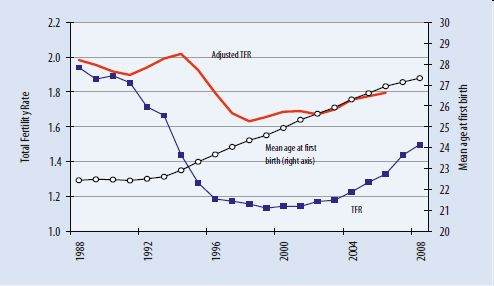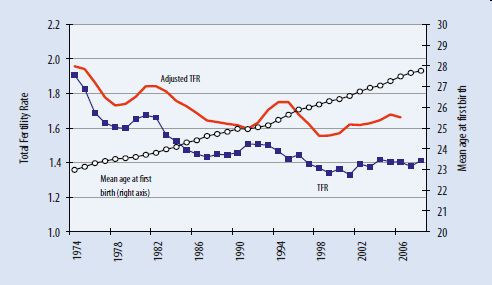Tempo Effect and Adjusted TFR
The conventionally reported indicator of the level of fertility in a given calendar year, the period Total Fertility Rate or TFR, reflects the interplay of two components: tempo (timing) and quantum (level) of fertility. When the age at which women give birth changes, the TFR is affected by this shift. Women in many European countries have been putting off births until higher ages for several decades and as a result, the mean age of childbearing has risen steadily. This childbearing postponement results in a decline in the number of births in a given period and therefore depresses the period TFR, even though the number of children that women have over their life course does not change. One can also think of this tempo effect in terms of an expansion of the interval between generations during which fewer births fall into each calendar year.
In order to come up with a measure of the level of fertility that is free from the tempo effect and thus constitutes a better indicator of the average number of children per woman in a given year than the period TFR, the “tempo-adjusted TFR” was developed. In this datasheet the adjusted TFR is calculated on the basis of the Bongaarts-Feeney (1998) formula which uses fertility data by birth order (see online Appendix for more details). When available, the datasheet gives the mean of the adjusted TFR for the three-year period of 2005–2007. This reduces annual fluctuations that are often quite large in the adjusted TFR. For countries where no such data are available for 2005–2007, the adjusted TFR is estimated either with the most recent available data or from the overall mean age of childbearing. The table on the front side shows both the conventional and adjusted TFR for individual countries in Europe. To gain a better understanding of these two indicators and their interplay with the changes in the mean age at first birth, this box provides an illustration of their developments in three European countries.
Figure 1 illustrates the tempo adjustment for the Czech Republic where childbearing postponement became particularly pronounced after 1990. The period TFR fell sharply in tandem with an increase in the mean age at childbearing, reaching a low of 1.13 in 1999. Subsequently, the TFR recovered substantially and increased to 1.50 in 2008. However, the adjusted TFR has remained at considerably higher levels after 1990 and reached 1.80 in 2005–2007. This indicates that most of the precipitous fall in the TFR during the 1990s was driven by a marked postponement of first births rather than by a genuine decline in fertility level and suggests the potential for a further increase in the period TFR.

Austria is an example of a low-fertility country with comparatively smaller fluctuations in the TFR during the last two decades. Fertility postponement has proceeded with a lower intensity there and consequently the gap between TFR and adjusted TFR is less pronounced (see Figure 2). In 1986–2006, the average TFR level was 1.42, whereas the average for the adjusted TFR was 1.64. So far there have been no signs of a diminishing of the tempo effect as shown by a steady increase in the mean age at first birth and the persisting gap between TFR and adjusted TFR.

In Spain (see Figure 3) the pattern has been quite different, with the adjusted TFR at first following the decline in the conventional TFR and a divergence only emerging during the early 1990s. Recently the increase in the mean age at first birth has levelled off at a high value close to 29.5 years. As a consequence, the difference between the two fertility measures has disappeared, resulting in an increase in the TFR to the level of the adjTFR by 2006.
